
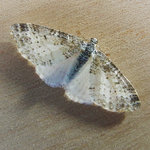
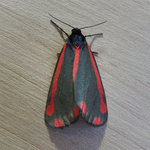
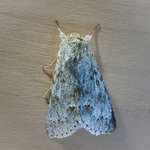
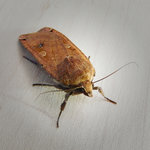
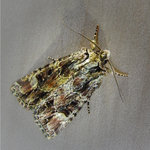
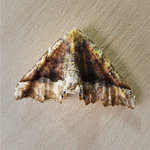
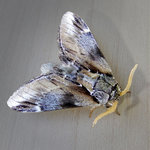
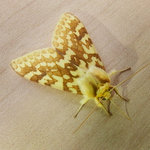
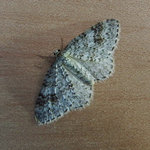
The days are hot and the nights are warm. By day I’m lucky to see two or three butterfly species. By night the moths swarm, pale shapes like prisms around the edges of my house. At my black light trap, where I catch moths for portraits before releasing them, I find 10, 15 species in a night. With a close look, their beauty matches that of their day-flying cousins, and their diversity, night after night as more species are revealed, each with its own pattern, is wild. A tiger moth arches pure white wings to hide an orange and black body. A lappet moth with cinnamon scalloped wings tucks its head next to leaflike flanges. A dozen micromoths rest like windblown flower petals; I hope to someday learn their names.
The third week in July is National Moth Week. To prepare I’ve been documenting the moths in our area.
In a way, this new practice of examining them, learning and photographing them, is a form of penance. I’ve had a long journey with moths. In the not-too-distant past you could find me shouting and cowering when I reached from the shower and one flew from my towel. I once killed a moth on a wall by throwing a book at it. It left a gray dust on the wall. Now I know that what looked like dust had been the scales that patterned its wings. I don’t know why my fear was so intense. I even published a piece with the line, “They are night-riders birthed in Satan’s closet.” I was trying to be funny. And people laughed. But humor born in fear rarely stays funny. It’s a dead-end street.
Penance, on the other hand, is supposed to be a mud pit. Yet these moths have opened to me a vista. After beetles, moths and butterflies are the most diverse order of insects, with 155,000 described species and counting. In North America there are about 700 species of butterflies. There are over 12,000 species of moths. Why such diversity? And what does it tell us about the world around us?
For an answer, it helps to pay attention to the way moths spend most of their lives — as caterpillars. Caterpillars can be found on every kind of flowering plant, and they have adapted to chow down on leaves in unique and intricate ways. Most of them specialize on a single family of plants, or even a single species. The free-flying adults show up anywhere — they sip nectar here and there to fuel their flights in search of mates, or lack mouthparts entirely and do not feed — but the caterpillars are always near their plants of choice. And plant diversity is legendary.
Recent research supports a long-held hypothesis that flowering plants and moths diversified in tandem, each reinforcing the others’ proliferation. Using the genetics of hundreds of moth species and models that calculate rates of evolutionary change, scientists have sketched out the moth family tree, peering into deep time to see when the major lineages diverged.
Sure enough, a major radiation happened in the Cretaceous period of 90 million years ago, the time of the dinosaurs, when flowering plants spread rapidly across the world, evolving into thousands of fantastic forms and challenging the reign of conifers, ferns and cycads.
The other night a moth of the genus Pero appeared, looking like a little hieroglyph, its wings stiff and crossed with a twiglike streak. In terms of numbers, Pero are similar to hummingbirds — the genus has about 300 species, all in the Americas, in every conceivable habitat, with its highest diversity in the mountainous terrain of South America where bands of unique vegetation stripe valleys many thousands of feet deep. Topography and diversity go hand in hand.
But there are other reasons for diversity. Two megadiverse moth families with hundreds of representatives on the Key Peninsula, Noctuidae and Geometridae — the genus Pero is in the family Geometridae — achieved their incredible numbers 60 million years ago, long after the Cretaceous explosion of flowering plants. It’s not a random number. It follows close on the heels of one of the most destructive events in Earth’s history: the famed dinosaur-killing asteroid impact. So much dust went into the atmosphere that all photosynthesis stopped for months or years. 80% of animal species went extinct. The few survivors held on by a thread. When the sun returned and plants regrew, they spread into a landscape in which everything had been rearranged. With most of life reduced to ghosts, moths and mammals had space to radiate into a multitude of species.
So moths make great bellwethers. Scientists call them bioindicators: diverse, intimately connected with plants, responsive to change. You could blindfold me, spin me around, drop me off at night in a dark place and, assuming I had my black light trap in my back pocket, I could get a pretty good sense of the terrain based on the moths that paid me a visit. By sampling moths over the coming years, identifying patterns, I hope to witness in real time the ways the wild life around us, from moths to caterpillars to flowering plants and right down to soil and moisture, is reacting to the changes rocking our landscape.
Scientists who study deep time talk about “the great adaptive radiations of the past,” each following an asteroid-level trauma. Today the trauma is far more diffuse — patches of clear-cut and pavement and sprayed chemicals intermixed with preserved forest and overgrown margins. It’s an ongoing freeform rearrangement of wild communities, with the losses far outweighing the rebirths. What will result from such trauma? How many species will slip away like ghosts beneath our notice? Will wildlife adapt, or will it take deep time for species to radiate again?
As I prepare for National Moth Week, I’m thinking about just how much of the rearrangement is akin to throwing a book at a moth on a wall. Ignorance and fear walk hand in hand. Our default preference is the blank wall, the mowed lawn, the simplistic idea of Moth, rather than the tangled wild filled with hundreds of moth species, each with its own story.
Having begun to appreciate the vista that moths provide, the blank wall sure seems like a lonely thing.
UNDERWRITTEN BY THE FUND FOR NONPROFIT NEWS (NEWSMATCH) AT THE MIAMI FOUNDATION, THE ANGEL GUILD, ADVERTISERS, DONORS AND PEOPLE WHO SUPPORT INDEPENDENT, NONPROFIT LOCAL NEWS